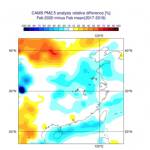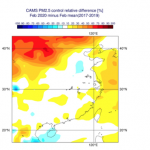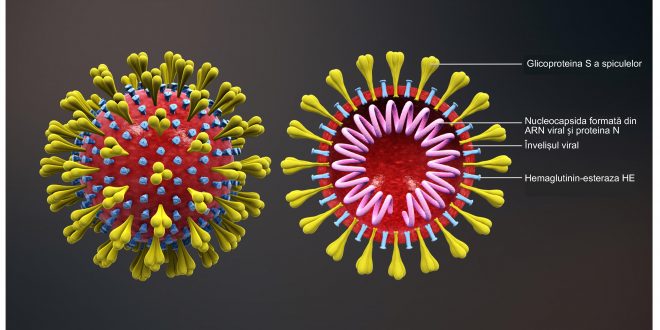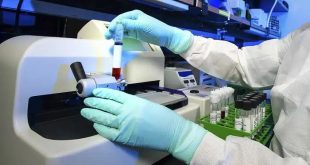After measures were taken to halt the spread of the COVID-19 virus, the Copernicus Atmosphere Monitoring Service (CAMS) monitored reduced levels of PM2.5 likely linked to the precautions.
As news of the COVID-19 virus broke out in Hubei province, China, in late December 2019, the Chinese government has since begun taking measures to reduce the risk of spreading the illness. As a result, daily activities, including industry and traffic, have significantly decreased within the last few weeks. As a likely side effect of this, the Copernicus Atmosphere Monitoring Service (CAMS) observed a decrease of fine particulate matter (PM2.5) for February relative to the previous three years. PM2.5 is one of the most important air pollutants regarding health impacts according to the World Health Organization. PM2.5, from its name, is used to describe particles that are 2.5 micrometres and smaller in size. These particles, either solid, gas or liquid in composition, have potential to pose serious health problems when inhaled into the respiratory system and are known to trigger or worsen chronic diseases and other respiratory problems.

CAMS monitors PM2.5 over China by combining observations from satellites with detailed computer models of the atmosphere resulting in daily analyses. When comparing the difference between the monthly average for February 2020 and the mean of monthly averages for February 2017, 2018 and 2019, it clearly shows that these analyses indicate a reduction of about 20-30 % in surface PM2.5 over large parts of China in February 2020 based on information from the satellite observations. The reduction in PM2.5 can likely be attributed in part to the slow-down in activity due to measures against the COVID-19 spread.
“Yet other variables, next to the shutdown, could potentially play a role in the decrease that we have monitored”, explains Vincent-Henri Peuch, Director of CAMS. “China is for instance actively trying to reduce emissions, and meteorological variability between different years must be considered as well. To subtract these variables out of the equation, we set the duration of three years 2017-2019 to estimate the ‘business as usual’ conditions as a compromise to have a representative estimate of February’s monthly mean, while not considering too long of a period over which emissions vary substantially because of long-term trends.”

Satellites generally measure quantities corresponding to vertically integrated amounts and not directly the surface values, the latter being what actually matters for air pollution and health. CAMS uses advanced numerical models of the atmosphere to turn information from satellites and other observational sources into more directly actionable products, such as surface concentrations. The main shortcoming of using numerical models is that one needs prior estimates of emissions of pollutants, which is done by using so-called emission inventories. These inventories generally ignore “unexpected” or “temporary” emissions changes, such as the potential decrease due to COVID-19 measures. However, by combining these models with observations by means of using methods initially developed for Numerical Weather Forecasting, we obtain “analyses” which are in principle capable of retaining the information of satellite observations and calculating their effect on the surface concentrations.
To further substantiate this finding, CAMS has also produced the same difference between February 2020 and the February mean for 2017-2019 without using the satellite observations. Because the PM2.5 values are in this case only dependent on the prescribed emissions and the meteorological conditions, it can provide a reference for the difference where satellite information was used as well. The figure clearly shows a zero difference between 2020 and 2017-2019 over most parts of China.
SOURCE// European Centre for Medium-Range Weather Forecasts
 الشبكة اليمنية للعلوم والبيئة (يمن ساينس) موقع يهتم بأخبار العلوم والتكنولوجيا والصحة والبيئة والسكان
الشبكة اليمنية للعلوم والبيئة (يمن ساينس) موقع يهتم بأخبار العلوم والتكنولوجيا والصحة والبيئة والسكان





